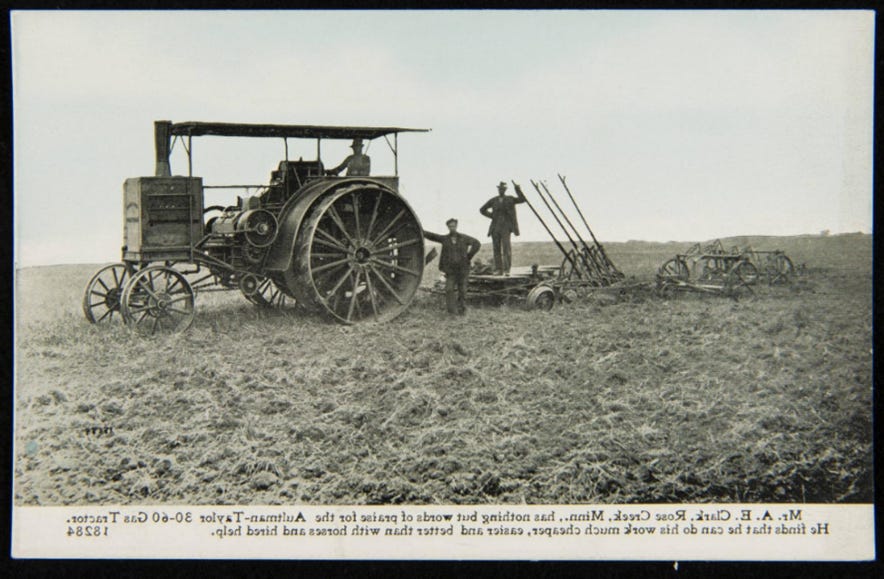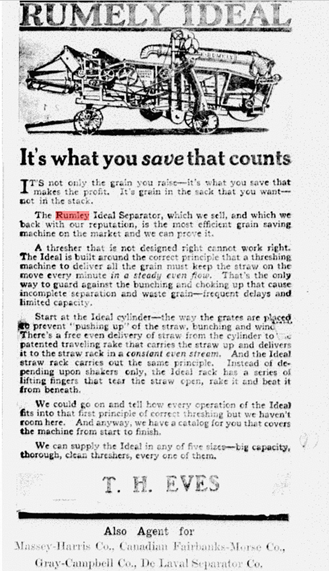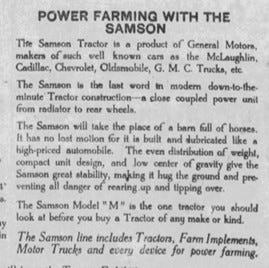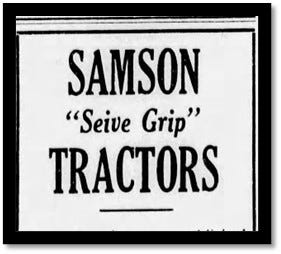The Canadian Pacific Railway (CPR) arrived before Strathmore did. The railway had been sweeping past since 1883, stopping at a little siding beside Eagle Lake and the Western Irrigation District established their headquarters in 1904. It was a community set up for success, with two important anchor tenants in place.
Agriculture and the railway would shape the district. The Strathmore Demonstration Farm provided advertising for the CPR as it promoted the area to potential settlers from around the world. It was the home of the CPR’s prize-winning herd of Holstein cattle, and it raised food and flowers for the tables of their elegant railway dining cars for more than forty years1. The “Lady Shaughnessy” carnations were developed and raised in the greenhouses on that farm; they were a pretty shade of yellow that was scarce at the time2.
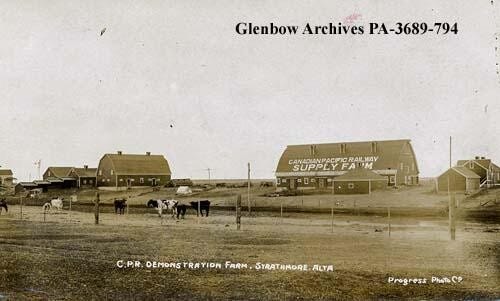
Potential settlers to the area were typically experienced farmers. The new arrivals, arriving in waves throughout the 1910s, needed places to shop, and that was where Strathmore, with a setting right on the CPR line, became a significant distribution centre. The very first edition of the Strathmore Standard listed three implement dealers, three hardware stores (one of the owners later became an undertaker), and two harness shops. Strathmore was home to John Deere, Massey-Harris, International Harvester and Case dealers. It also hosted agricultural brands that ultimately didn’t last, even if they were popular at the time and sold good products. This article will highlight early businesses with less familiar names, but with interesting stories and iconic merchandise.
Aultman & Taylor Machinery Co.
Harry and Christina (Elliot) Anderson were both born in 1853, fourteen years before Canada officially became a country. The pair were married as sixteen-year-olds, and they were destined for a life of adventure. In 1879, their growing family made their way west from Ontario to a farm near what is today Crystal City, Manitoba. The CPR had not yet stretched as far as Manitoba in 1879, so Harry and Christina took the train to St. Paul, Minnesota and travelled by ox cart the rest of the way. When they reached the Red River, Harry swam across it, leading the oxen. His wife, children and everything they owned were balanced precariously behind him in the cart. The Andersons arrived in Strathmore in 1910 – by train, this time.3
H. Anderson & Son began operating an Aultman & Taylor dealership in 1914. Aultman & Taylor were an American company that had manufactured steam traction engines, but by the 1910s, they were transitioning to gas powered equipment. One of their biggest and most popular models was the 30-60. It was a massive tractor, weighing in at a breathtaking 24,450 pounds. That big machine could drag eight to ten bottom plows, and it could power enormous threshing machines.4 It was ideal for the big farms in the Strathmore area. The operator’s station of the 30-60 was open but covered by a canopy, and the company advertised that their equipment was easy to repair and operate. It could also run on affordable fuel options such as kerosene5. You can judge for yourself if this tractor was easy to run by watching this start up demonstration of the Pioneer Acres 30 – 60 Aultman & Taylor right here! (Video courtesy of @Rainhill1829).
Christine and Harry were both devoted church goers; Harry served on the Town Council and Christine with the Ladies’ Aid. Altogether, nine children would join the Anderson family. Harry and Christine spent the rest of their lives in Strathmore, and it was said that they were the first couple in town to celebrate their sixty-year wedding anniversary. On Saturday nights, it was customary for their farming friends to drop by for a cup of tea and a visit after the weekly shopping trip to town6.
By 1917, H. Anderson and Son had switched to operating the Maple Leaf Gas Pumps and the John Deere Implement Agency in Strathmore.
Rumely
Meanwhile, the Rumely agency saw ownership turnover through the 1910s. Shilson & Goffrier opened the shop in 1910. In 1911, W. G. “Bill” Knyvett took it over briefly. Bill seemed to have had his fingers in quite a few local enterprises. His other industries were listed as “livery barn, draying etc.” He was also associated with a billiard business7 and was farming his own land too.
Bill was originally from New Zealand and had arrived in Strathmore in 1907, but he wasn’t there for long when the Great War disrupted his life. Bill and his brother Edward joined the 43rd Battalion, the Cameron Highlanders of Canada. Edward was killed at Le Mans and Bill was gassed at Ypres. It was when he was sent to England to recover from his injuries that he met a widow, Maria, from Portugal. Maria already had a little girl, Sylvia. Bill and Maria were married, and the trio travelled back to Canada together in 1918.8
The farm that Bill had left behind in Strathmore was understandably the worse for wear. The livestock were long gone, and the roof of the house was “very well ventilated” as Sylvia later recalled. The trio were just getting settled in their new home when the influenza epidemic attacked their community and everywhere else in Alberta. While Maria nursed the sick, Bill brought groceries to neighbours who couldn’t leave their homes.9
Bill had briefly owned his farm equipment business in 1911. He sold it to Tom Eves, who also had a harness shop. Tom was born in England and came to Strathmore in 1911. He and his wife Lily made their way to western Canada with stops in New York City and Quebec along the way. The pair had four children.
Like Bill before him, Tom recognized that mechanized farming was becoming more mainstream. He was the agent for Fairbanks Morse stationary engines and Massey-Harris as well as Advance-Rumely (after acquiring the Advance Thresher Company and others the organization became the Advance-Rumely Company in 1915). Rumely built tractors, stationary engines and separators. Before combines, threshing machines and separators handled the harvest. The multi-ton Rumely Ideal was designed to have four men at a time pitching bundles of grain into the feeder. Some models could thresh over 2,500 bushels a day, and Tom temptingly ran advertisements in the lead up to harvest in the July and August issues of the Strathmore Standard to market the product.
(Advance-Rumely bought the Aultman-Taylor Company in 1923 and then was itself taken over in 1931 by the Allis-Chalmers Manufacturing Company.)
In 1924 a fire wiped out not only Tom’s business, but a considerable portion of Strathmore. It began on the morning of 10 July upstairs in the Opera House. There was no water system in Strathmore at the time, and it took the Calgary Fire Department four hours to arrive. The fire escaped and began spreading to other buildings. The Opera House was destroyed, along with a drug store, a jeweler, the doctor’s office, and Tom’s building.10 The financial loss finished Tom’s business; he transitioned into working for Robin Hood Flour and De Laval.11
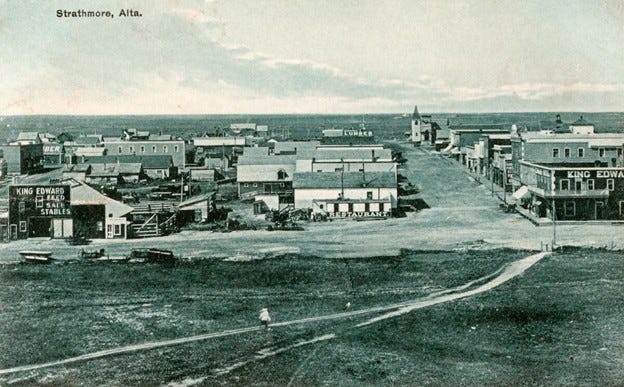
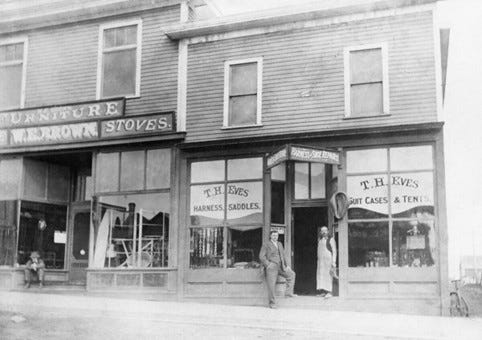
Samson Tractor Company (GMC)
The Samson Iron Works, later rebranded the Samson Tractor Company, was an American brand that sold both trucks and tractors. In 1917, a very interesting development occurred when General Motors Canada (GMC) took over the company. Their advertising in the Calgary era promoted this Canadian angle to their potential customers.
Though the arrangement was short-lived, it produced a unique and collectable tractor. The Sieve-Grip was a three wheeled design that had perforated metal wheels. The open tread offered traction on hillsides and in river bottoms. Sieve Grips, which came in two models, a 6 – 12 and 10 – 25, were deep, wide tractors perfect for working in the vineyards and orchards of southern California from whence they originated. The tractor’s gears were enclosed to protect them from dust, a rare feature at the time – there was one forward gear and one reverse. A handy arrow mounted on the front wheel told the operator which direction they were travelling; the seat was so low slung that the driver couldn’t see over the hood.12 You can watch the Sieve Grip 30X in action at Pioneer Acres right here (video credit @Rainhill1829).
GMC was attempting to go head-to-head with Henry Ford’s Fordson tractors, fitting the Sieve-Grip with their own 30 HP engine, but the Fordson F model decimated their competition.100,000 Fordsons were built in 1923 alone while by 1922 GMC had stopped manufacturing tractors altogether.13
In Strathmore, Harold Bell briefly ran the Samson dealership; it was listed as operating for a single year in 1923. However, he also sold a variety of other equipment. Harold was interested in the radio technology that was becoming more commonplace across the prairies. He sold Westinghouse radios and had a fine instrument of his own installed in his office. Concerts from across North America could be heard, and neighbours telephoned the office so that they could listen to the broadcasts over their telephones!14 And on 4 July 1923, boxing fans caught the Dempsey-Gibbons fight live through the magic of radio broadcasting.15
Aultman & Taylor, Rumley and Samson were all examples of farm equipment manufacturers that came and went in a time of great change, not just for Alberta but for agriculture. All built products that were well liked at the time, and Samson even won a prize for their designs. The early twentieth century saw steam and gas agricultural equipment competing with horses. Demand for mechanization was increasing steadily through out the 1910s, and that meant that rivalries were increasing between manufacturers. Finally, the large equipment that had been needed for breaking prairie sod at the beginning of the decade was already being replaced by smaller tractors that had just as much horsepower by the end of it.
Business owners in Strathmore – and everywhere else – faced worldwide events that were beyond their control during the period. The First World War and the influenza epidemic had a disruptive impact not only on people’s businesses, but on their lives. The 1924 fire was a critical moment in Strathmore’s history, and it wiped out significant enterprises that had previously been profitable and successful.
Strathmore today is still shaped by agriculture. The United Farmers of Alberta (UFA) has a supply store (and gas pumps), and the Western Irrigation District still operates its headquarters from Strathmore. Strathmore is surrounded not only by farms, but by feedlots, and agricultural businesses are needed to support livestock as well as grain farmers. Strathmore is a self-contained place, with its own schools, hospital, churches and shopping. Ironically however, customers wanting to buy a combine, parts for a baler or a new tractor must travel elsewhere – for instance, the nearest Brandt (John Deere) locations are at Bassano or Balzac.
Allison, R. S., Strathmore: the Village that Moved, p. XII
Trees, Strathmore: the Village that Moved, p. 22
Robison Cleve, Iola, Strathmore: the Village that Moved, p. 262
Bixler, Lorne, History of Aultman & Taylor Part X, Farm Collector Magazine, published 1 May 2002
The Aultman-Taylor Tractor, Calgary Canadian, 29 June 1918, p. 37
Robison Cleve, Iola, Strathmore: the Village that Moved, p. 262
Strathmore: the Villlage that Moved, p. 69
Humble, Sylvia, The Knyvettes, 1907 – 1931, Strathmore: the Village that Moved, William “Bill” Knyvett, p. 425
ibid
Sonsteby, Paul, 100 Years of Memories: Celebrating Strathmore’s Centennial, p. 41 – 42
Eves, Ereda, The Eves Family, Tom and Lily, Strathmore: the Village that Moved, p. 327
Boblenz, James N., The Sieve-Grip Samson Tractor, Farm Collector, 1 June 2007
Moore, Sam, Samson Tractor Was GM’s Response to Fordson, Farm Collector, 1 May 1999
Local Jottings, The Strathmore Standard, April 18, 1923, Page 2
Local Jottings, The Strathmore Standard, July 11, 1923, Page 6
Thank you to Shelly McElroy for preparing this story.
Thanks also to the Historical Society of Alberta for their funding support.




